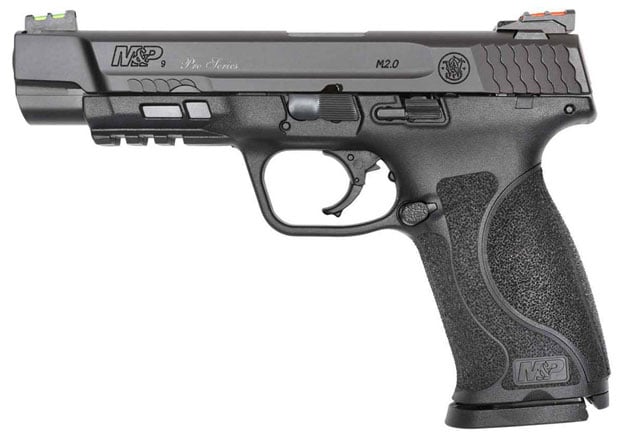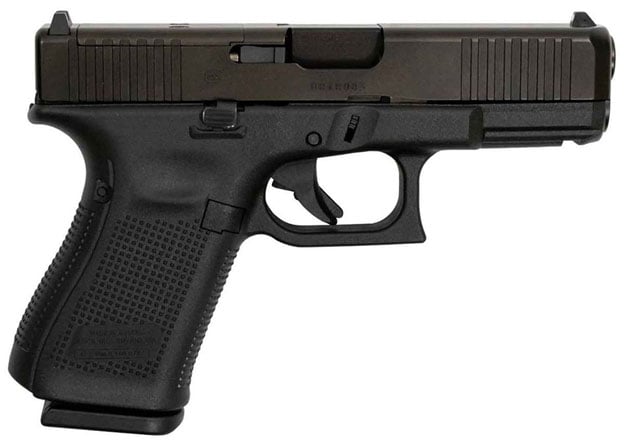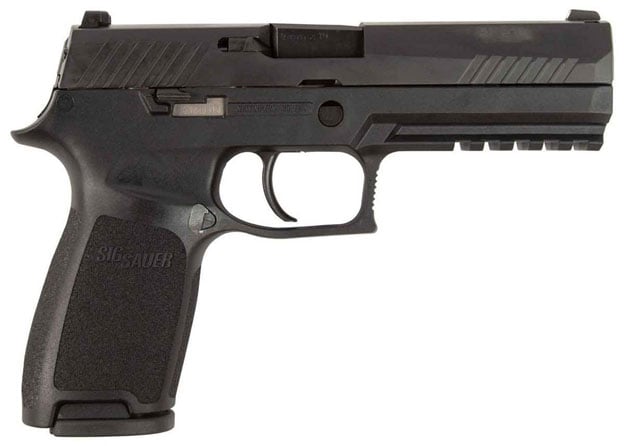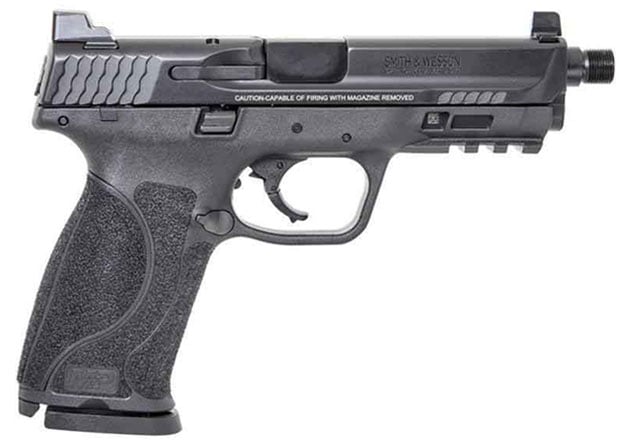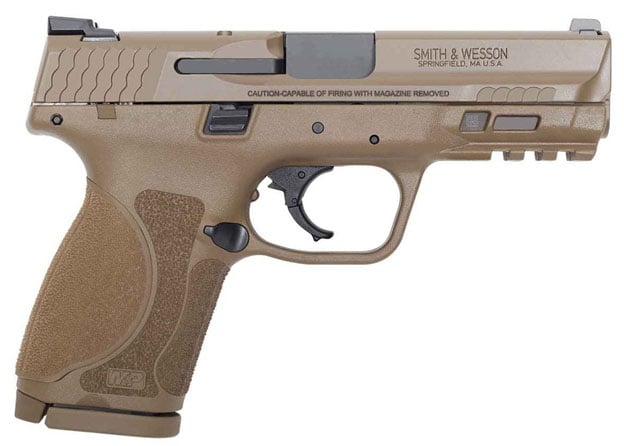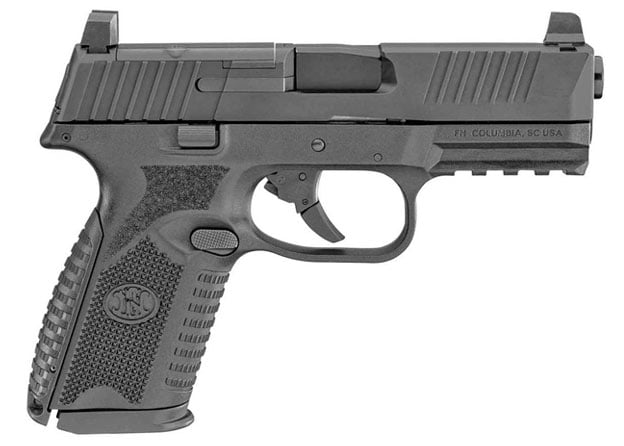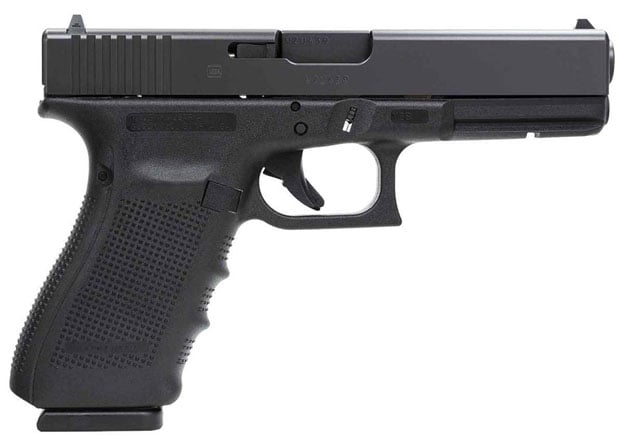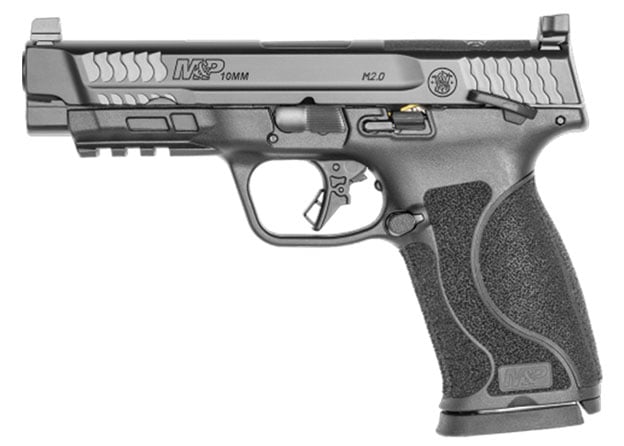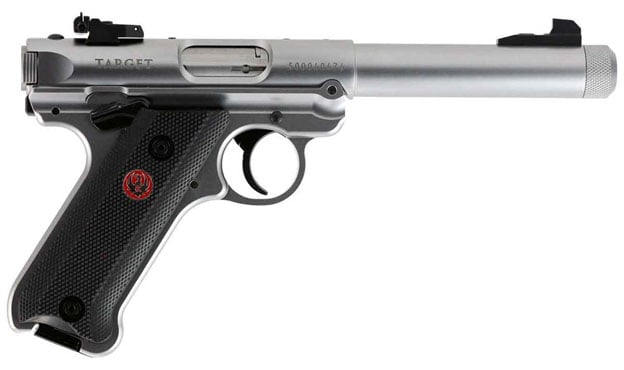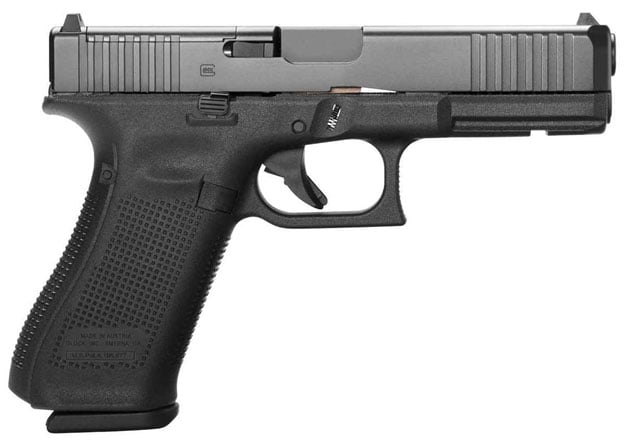10 Best Handguns for Beginner Shooters
By Trent Gander |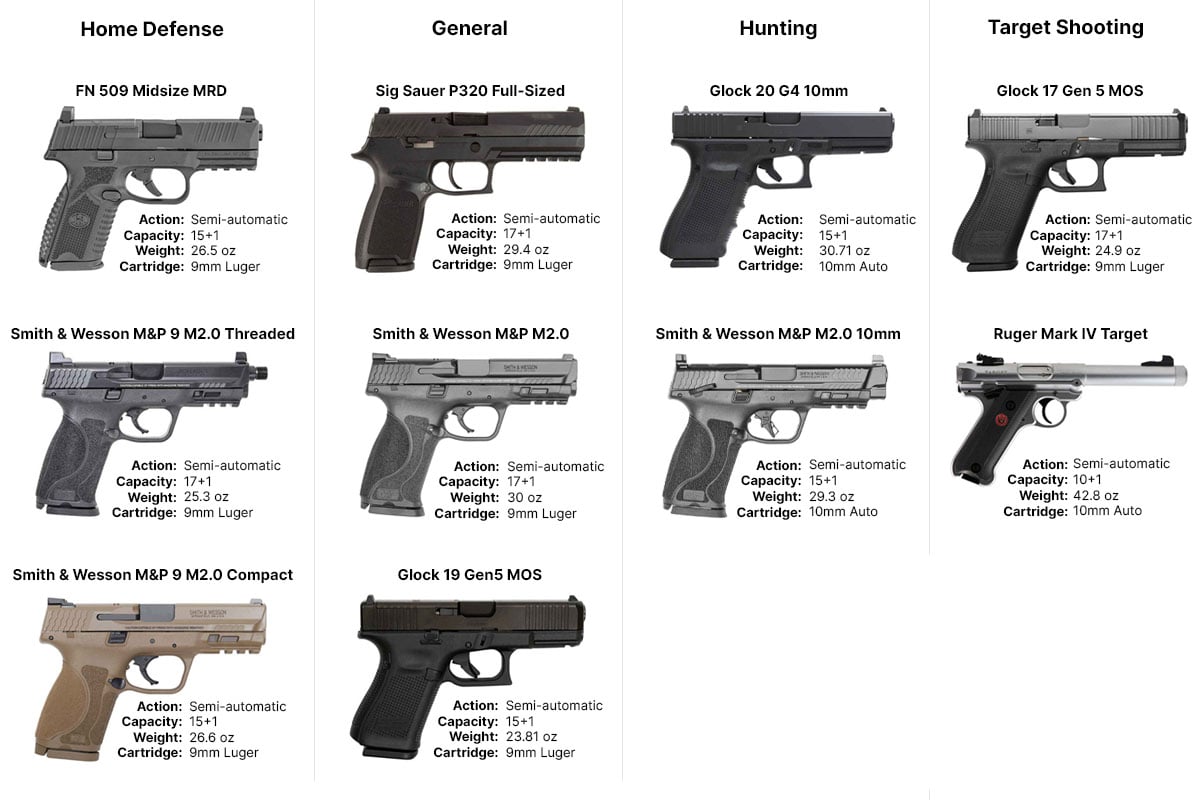
New gun owners are entering the market all the time, this might be out of necessity or out of interest in shooting sports.
This means there are a lot of people who don’t know what to look for in a handgun that are purchasing handguns. There is a general idea that they have but it might not be the best option for them. So what is the best option?
This comes down to the application they need the handgun for. We’re going to go over the best features a handgun needs for a new shooter and some of the best handguns depending on their application.
Beginner’s pistol quick guide
A beginner’s pistol should be simple to operate with a low learning curve. This means a semi-automatic, striker-fired pistol with very few controls in a common caliber is the best option for a new shooter.
This is still a large number of handguns and the options can be overwhelming to someone who is not used to guns.
We’re going to break down the aspects of a good pistol to help you decide which one is best for you.
Pistol criteria & use
There are going to be certain criteria that a pistol needs to be beginner friendly, it also needs to be able to fill a role that you need.
This means we need a pistol that is going to be reliable, last a long time, not be too expensive, and allow for the user to grow with the gun.
Many modern manufacturers have started producing pistols with similar characteristics. This means we’re seeing less variety as the market as a whole figures out what has worked in the past and capitalizes on it.
This unfortunately makes it even more confusing for new shooters to pick between guns that are on the surface the same but at a different price point. Why does this gun cost $200 more despite working the same way?
The price difference in pistols generally comes down to parts quality which equates to reliability. There are some price increases that are related to name recognition but for the most part the $400-$700 range is where we find the best cost/reliability ratio for a handgun.
The guns on this list fall into that price category in order to provide the most value while taking into consideration the needs of the shooter. This is especially important if the new shooter can only afford one or two handguns at most.
Let’s look at the aspects of a good pistol.
Pistol aspects
Pistols are very challenging guns to get into if you don’t know what you’re doing. This tends to lead new shooters to select handguns that they think are good but might hurt them in the long run.
Even if they are new shooters they will still have an opinion and bias about certain firearms because of things like movies, video games, and TV.
Firearms tend to work very differently from how they are usually portrayed in shows. While there has been a trend for more accurate representations of firearms in film, this doesn’t change the fact that there are a lot of inaccurate representations and tropes that are perpetuated through the influence of TV and movies.
There are a few considerations we need to make in selecting a handgun for a new shooter, let’s go over them.
Why Semi-Automatic?
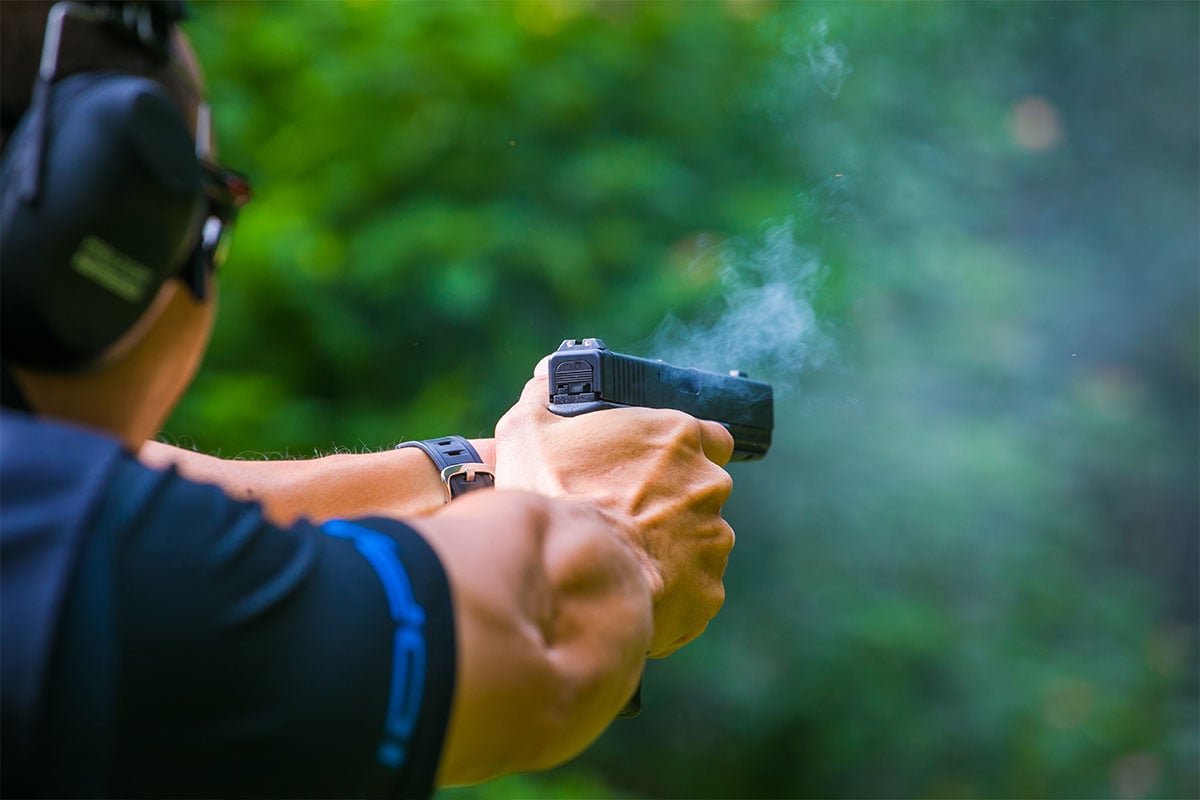
Why choose a semi-automatic pistol instead of a tried and true design like a revolver? This comes down to maintenance, reliability, and simplicity.
While revolvers are portrayed as being extremely simple guns, they are actually very complex in their operation. This can lead to unnecessary danger to the end-user if they don’t know how to properly care for a revolver.
If a revolver is poorly maintained or heavily worn, its timing can be off. What does it mean if the timing is off? The timing of a revolver is how accurately the cylinder rotates and lines up with the barrel.
If the bullet is not properly aligned to go down the barrel of a revolver it can destroy the revolver and injure the user. This is from the bullet detonating and going into the frame rather than down the barrel.
Additionally the revolver has a lot of small parts inside of it that need to be maintained. If one of those parts breaks or the revolver jams it requires a gunsmith in order to fix.
This is not the case with a semi-automatic. Most malfunctions can be fixed on a semi-automatic by dropping the magazine, racking the slide one or more times, and re-inserting the magazine.
Most modern semi-automatics can be easily taken apart and put back together, also known as field stripping, with little to no tools. This allows for easier maintenance and operation.
Why no external safety?
This is a more nuanced aspect of a handgun. There have been many designs that feature external safeties. Even some modern designs have had external safeties added to them with their adoption to the military.
But why should a beginner not have an external safety on their gun? While the external safety can help prevent an accidental discharge it can become a crutch that can lead to the ignoring of the rules of firearm safety.
This is a significant problem especially since external safeties and internal safeties can fail. If the rules of firearms safety are followed, we have a much larger margin of error should one of the safeties fail.
The next aspect of why external safeties should be avoided is self-defense. While you can train to deactivate the safety while drawing the gun, it takes hundreds if not thousands of repetitions to become consistent at it. This is magnified when we add simulated stress which means under actual stress we run the risk of not deactivating the safety.
If you’re not going to practice deactivating the external safety regularly, it’s better to not have it rather than relying on it instead of practicing proper firearm safety.
Why striker-fired?
More and more modern handguns are going to striker-fire. This is because of two reasons: simplicity and consistency.
Striker-fired guns are double-action-only. This means that the trigger pull will be the same each time. With some hammer fired designs, the first trigger pull has to cock the hammer and tends to be heavy. Once the hammer is back the trigger becomes lighter, which means we get two different trigger pulls from the same gun.
This adds another variable to our shooting. The first heavy trigger pull can throw off our shot if we are not thinking about it or controlling our gun enough. The initial shot can be very important. This means a consistent trigger pull makes it easier for us to perform under stress.
Strikers are also better contained and simpler to use. Their parts can be swapped out if they break. This can be done more easily than with a hammer-fired mechanism. Dirt and debris have a harder time going into enclosed systems like striker-fired guns leading to better reliability.
Size
Guns have an inverse law of controllability. The larger the gun, the easier it is to control. Many people select very small handguns because they think the gun will be easier to control than larger guns.
This is not true for multiple reasons. The first reason is that the larger gun tends to have a larger grip. This larger grip allows for you to put more of your hand in contact with the gun. This is extremely important for handguns since our grip strength and hands are our only methods of controlling the gun.
Not getting a full grip on the gun makes it harder to control the recoil. More contact means a better grip, which in turn leads to better recoil control.
Another factor of the size of the gun is weight. Larger, heavier handguns help with recoil mitigation. This results from the recoil having to move more weight than with a smaller framed gun.
This means that sub-compact handguns are harder to master than compact handguns, which are harder to master than full-sized pistols.
However, compact and full-sized pistols vary from brand to brand. Some companies have compact pistols that are closer to full-sized handguns while others have full-sized handguns closer in size to compacts.
If you can only get one pistol, it’s better for it to be a full-sized handgun or larger compact than a sub-compact pistol.
Modularity: lights & sights
Being able to easily increase the ability of our pistol is very important if we are only going to have one. Especially if this is our first pistol.
Easily replaced sights and the ability to add a red-dot optic to our gun are something we need to consider. This is because sights are how we determine where our shots go. Good iron sights and the ability to use a red-dot will help us get the most out of our pistol’s accuracy.
Additionally the ability to mount a weapon light is one of the most important factors for handguns intended for self-defense and home defense.
Weapon mounted lights allow us to be able to see in a variety of different ambient lighting scenarios. We need to be able to identify potential threats and having a light always with the pistol can be handy.
Weapon mounted lights are no replacement for a good handheld light, but should be considered for self-defense and home defense.
Caliber
What we use our handgun for determines what caliber we should use. It’s better to have a handgun in a common caliber in order to keep up a supply rather than have an obscure or rare caliber.
Purchasing something that is readily available will allow you to do live-fire practice and allow you to stock up on your selected round.
But we’ll cover which calibers are better for which task in their respective sections.
Self-defense
Self-defense is a common reason for people to purchase a handgun. They are easily carried and offer a good level of protection with modern self-defense loads.
Modern handguns offer a lot of benefits over some of the more traditional options. This comes down to capacity, modularity, and aftermarket support.
Let’s start off with one of the basic considerations, capacity.
Capacity
Capacity is how many bullets are held in the magazine of the gun. For our modern self-defense pistols this will be a minimum of 10+1 in compact or full-sized handgun. This mostly comes down to legal restrictions.
Some locations do not allow magazines to hold more than ten rounds while most standard handguns have a 15+1 or 17+1 capacity. This does change with caliber but for now we’re assuming a standard 9mm handgun.
Why so many bullets?
Looking at violent crime statistics shows that most violent encounters involve an average of three rounds expended per assailant at a minimum. With larger and larger groups assaulting individuals and invading homes we need more rounds to defend ourselves with.
Closely tied to capacity is the caliber we select.
Caliber
There are three major calibers selected for self-defense: .45 ACP, 9mm, and .40 S&W. However only one of these offers numerous benefits with few downsides.
Of these three, 9mm has become the standard self-defense round. This is because it offers a higher capacity, lower recoil, and good terminal effectiveness with modern hollow points.
Using 9mm gives us a large variety of rounds to choose from. This allows us to select the right one for training and self-defense. It also means that at least one variety of it is available to us most of the time.
Modularity
Modularity is very important for a self-defense handgun. This is because many of the accessories we can add to a pistol are considered force multipliers in a self-defense situation.
A good set of iron sights and a weapon mounted light are good options on a budget. Many modern handguns do have better iron sights than previous iterations, but as red-dot technology becomes widely available we have to consider using them on our pistols.
Using a red-dot does have a learning curve, but it simplifies aiming. The red-dot allows us to focus on our target while aiming rather than the orientation of the front and rear sights. Even if you don’t start with a red-dot it’s a good idea to have a pistol already ready to accept a red-dot.
Being able to clearly identify a threat is one of the major reasons you should have a weapon mounted light. Being able to confirm that the bump in the night is actually a threat and not a family member will help keep the number of accidental shootings down.
If you only have the option to purchase a red dot or a light, purchase the light. The light is going to help you actually see in a wider number of environments compared to the aiming benefits of the red-dot.
Ideally you’ll have both which is why it’s better to purchase a pistol that can accept both from the beginning. That way you won’t have to pay for custom slide work to mount a red-dot.
Aftermarket support
Gun parts can wear out over time and magazines can fail. We need to know we can get parts and magazines for our pistol without breaking the bank.
Magazines are disposable. This means you should have more than the basic number that comes with whichever gun you choose. Having multiple magazines allows you to train more easily and have spares on hand just in case one begins to malfunction.
Other gun parts, like recoil springs, wear out over time. Granted this is over thousands of rounds but it’s good to think about the long term for gun ownership. Make sure you can get the extra parts you need without having to spend the equivalent of a new gun to get them.
10 best handguns for beginner shooters
Smith & Wesson M&P M2.0
Smith & Wesson’s M&P (Military & Police) series is a great option if you are just getting into firearms.
It has better ergonomics than Glock brand pistols and is one of their closest competitors in terms of concealed carry.
This full-sized pistol features a polymer frame with stainless steel chassis. Chambered in 9mm, it has a standard capacity of 17+1 and comes with two magazines.
The low bore axis aids in muzzle control, allowing for faster follow-up shots and better accuracy.
The Performance Center model features a front sight with a high visibility green fiber optic and the rear sight is adjustable with red fiber optics. Other options can come pre-milled to accept a red-dot sight and have their more standard front/rear sight packages.
Aftermarket support for the M&P is growing, allowing you to get the modifications you need. Magazines are going to be expensive, but this is because they are made out of metal rather than polymer like Glock aftermarket magazines.
This difference in magazine design helps ensure that the magazines drop free after hitting the magazine release, helping to speed up reloading.
The 2.0 line in most of its forms is great for both self-defense and home defense. We will see multiple versions of it on this list.
Smith & Wesson M&P M2.0 Specs
| Action | Semi-automatic |
| Capacity | 17+1 |
| Barrel Length | 5" |
| Sights | Fiber optic Front sight Green, Adjustable Fiber optic rear sight Red. (model dependent) |
| Optics Ready | Model dependent |
| Cartridge | 9mm Luger |
| Weight | 30 oz. |
| Overall Length | 8.5" |
| Hand | Right |
Glock 19 Gen5 MOS
The Glock 19 set the bar for concealed carry that other pistols are measured to. This compact handgun is closer in size to a full-sized pistol than what most would think.
This allows it to provide a more comfortable concealed carry option without compromising on performance.
With the new Gen 5 models, the Glock 19 features a Glock Marksman Barrel, flared magwell, and the standard customizable frame backstraps.
The Gen 5 Glocks have gotten rid of the finger grooves for a getter grip and now includes ambidextrous slide stop levers.
The MOS model is optics ready and compatible with a number of red-dot sights with the included floor plates.
The Glock 19 has a base capacity of 15+1 but it has multiple larger magazines that it can use.
The aftermarket for Glocks is one of the largest for modern handguns. However you should make sure that the internal parts you get for replacements are made specifically for Gen 5 Glocks as the parts are not completely interchangeable.
Magazines are interchangeable and are one of the major reasons people select Glocks. However over time the prices of Glock mags have gone up, placing them on par with most magazines unless you use Pmags. This will place the cost of magazines to about half of the standard “name brand” price.
Glock 19 Gen5 MOS Specs
| Action | Semi-automatic |
| Capacity | 15+1 |
| Barrel Length | 4.02" |
| Sights | Glock Standard front and rear |
| Optics Ready | Yes |
| Cartridge | 9mm Luger |
| Weight | 23.81 ounces Empty with Magazine |
| Overall Length | 7.28" |
| Hand | Right |
Sig Sauer P320 Full-Sized
The P320 is one of Sig Sauer’s modern attempts at a striker-fired pistol. Developed for the US Army, this is a relatively new pistol when compared to both the M&P and the Glock.
While there were a few initial hiccups with the design, those problems have been solved. This makes the P320 another alternative to both Glock and the M&P.
This model features a set of SIGLite night sights. These allow you to be able to see your sights in low light scenarios. But they are not a replacement for a light. Some models are optics ready so make sure you get the one that fits your needs.
A Picatinny is featured under the barrel for mounting lights and lasers. This allows you to pick the light you want without the restrictions smaller framed guns have.
Standard magazines for the P320 offer 17+1 capacity with two magazines included.
Sig Sauer P320 Full-Sized Specs
| Action | Semi-automatic |
| Capacity | 17+1 |
| Barrel Length | 4.7" |
| Sights | SIGLite |
| Optics Ready | Model dependent |
| Cartridge | 9mm Luger |
| Weight | 29.4 oz. |
| Overall Length | 8" |
| Hand | Right |
Home defense
Home defense and self-defense are very similar in the requirements they have. We need a handgun that provides us with a decent capacity and the ability to navigate our home in the dark.
On top of this we might be a little more willing to have a larger pistol that doesn’t leave the house.
Some pistol models come suppressor ready. This is important if you have a dedicated home defense pistol because gunshots in buildings will damage hearing if they are not properly mitigated. While suppressors won’t completely remove the danger, they will at least lessen the effects.
Treat all home defense options and self defense options as interchangeable.
Smith & Wesson M&P 9 M2.0 Threaded Barrel
A different variant of the M&P M2.0, this pistol differs in that it has a threaded barrel and 3-dot suppressor height sights.
The suppressor height sights are easier to see. This is because they are taller in order to compensate for aiming over a suppressor.
This is beneficial even if you do not choose to get a suppressor for this gun. Should you choose to get the slide milled for a red-dot the suppressor sights can be used to index the red-dot more easily.
Lining up the sights will bring the dot into view faster while also allowing you to have a set of backup iron sights. While modern optics are very durable with long battery life, it is always good to have a backup if the battery dies or is compromised.
The threaded barrel does accept a suppressor but many other muzzle devices can use the threading, just make sure the thread pitches are matched.
Smith & Wesson M&P 9 M2.0 Threaded Barrel Specs
| Action | Semi-automatic |
| Capacity | 17+1 |
| Barrel Length | 4.6" |
| Sights | 3-Dot Suppressor Height |
| Optics Ready | No |
| Cartridge | 9mm Luger |
| Weight | 25.3 oz. |
| Overall Length | 7.9" |
| Hand | Right |
Smith & Wesson M&P 9 M2.0 Compact
If you’re looking for an alternative to the Glock 19, this M&P compact is a good option. It packs all of the benefits of the full-sized pistol into a slightly smaller package.
The grip is adjustable with the interchangeable inserts to help you fit the gun to your hand like the other M&P pistols.
It can accept lights and other devices on the under-barrel rail, but the size of the rail might impede what lights you can use.
The capacity is also downgraded to 15+1 compared to the 17+1 capacities of the full-sized M&Ps.
Smith & Wesson M&P 9 M2.0 Compact Specs
| Action | Semi-automatic |
| Capacity | 15+1 |
| Barrel Length | 4" |
| Sights | 3-Dot |
| Optics Ready | No |
| Cartridge | 9mm Luger |
| Weight | 26.6 oz. |
| Overall Length | 7.3" |
| Hand | Right |
FN 509 Midsize MRD
While it is a slightly more expensive option, the FN 509 Midsize comes with a number of beneficial features.
The 509 features an improved trigger, full ambidextrous controls, and the ability to mount 10 different red-dot sights.
The MRD version of the 509 Midsize is optics ready. This is achieved with FN’s Low Profile Optics Mounting System. Being able to add a red-dot later without specialty milling makes this gun great in the long run.
The iron sights are set up to co-witness with the red-dot and can be used to charge the pistol if needed.
While it does have a 15+1 round base capacity, you can use large capacity magazines if you use the appropriate magazine sleeve.
FN 509 Midsize MRD Specs
| Action | Semi-automatic |
| Capacity | 15+1 |
| Barrel Length | 4" |
| Sights | Co-witnessed Iron sights |
| Optics Ready | Yes |
| Cartridge | 9mm Luger |
| Weight | 26.5 oz. |
| Overall Length | 7.4" |
| Hand | Ambidextrous |
Hunting
Hunting brings in its own particular problems when it comes to handguns. This is because when we carry a handgun while hunting it has to be powerful enough to defend us from both people and animals.
This means our standard self-defense round might not cut it when dealing with more aggressive animals.
Generally, this means the use of 10mm Auto. The 10mm cartridge is powerful enough to be used for defending against bears. Whether you would want to or not is a different story.
However there are several semi-automatic handguns that are chambered in 10mm that match our standard requirements for simplicity and ease of use. Just keep in mind 10mm packs a punch and can be heavy on recoil.
Heavy recoil is usually not recommended for beginner shooters because it can create flinches in the shooter. If you’re going to be using 10mm for hunting, you should get it after becoming proficient with a lighter caliber.
Glock 20 G4 10mm
The Glock 20 is one of the more affordable 10mm handguns out there.
Offering similar aftermarket support, this Gen 4 Glock comes ready out of the box. Chambered in 10mm Auto, it has significantly more power than 9mm options.
This allows it to be a good defensive handgun against game animals, but less ideal for things like normal self-defense and home defense.
Since it is a Gen 4 Glock, the Glock 20 has the distinctive finger grooves on the grip. If this impedes your grip on the gun, the ridges can be ground down flush to the grip rather easily. However, removing too much material can cause integrity issues with the frame.
The finger grooves are awkwardly placed, which caused many end-users to remove them. This is why Gen 5 Glocks no longer feature them.
The 15+1 is impressive seeing that it is a slightly larger cartridge, placing it on par with similar 9mm options. However it is slightly heavier than its 9mm counterparts in order to help deal with the larger recoil of 10mm.
This is a great option if you want an off the shelf hunting pistol that has good support in the aftermarket.
Glock 20 G4 10mm Specs
| Action | Semi-automatic |
| Capacity | 15+1 |
| Barrel Length | 4.61" |
| Sights | White Dot & Outline |
| Optics Ready | No |
| Cartridge | 10mm Auto |
| Weight | 30.71 oz. |
| Overall Length | 8.07" |
| Hand | Right |
Smith & Wesson M&P M2.0 10mm
Like the Glock 20, this M&P shares almost the same features of the base model of its line. While it is still chambered in 10mm, this is not the major difference between it and a standard 9mm M&P.
The primary difference between this model and the standard M&P is the inclusion of a thumb safety. This is a departure from our normal parameters but it is within our price point without going to more custom 10mm options.
This pistol also includes a pre-milled optic area. This means we can upgrade to a red-dot more easily than with the Glock 20. The sights are also red-dot compatible.
If you are going to use 10mm in a more serious capacity, these features start to outweigh that thumb safety. It will require more effort to train with, but it is easier to modify later on.
Glock 20 G4 10mm Specs
| Action | Semi-automatic |
| Capacity | 15+1 |
| Barrel Length | 4.6" |
| Sights | 3-dot front and rear |
| Optics Ready | Yes |
| Cartridge | 10mm Auto |
| Weight | 29.3 oz. |
| Overall Length | 7.9" |
| Hand | Right |
Target shooting
Target shooting is a fun sport to get into if you’re interested in guns. However proper target guns can get extremely expensive and serve no function outside of that narrow niche.
We are going to look at two pistols. One that is a more general use target pistol and the other that is a pistol that can serve as a target gun, competition gun, and self-defense gun.
In terms of target shooting, we’re looking at slightly longer barrels that focus more on accuracy than concealability.
In regards to caliber, most common rounds can be used in target shooting with .22 Long Rifle being used for more general target practice and things like 9mm for competition shooting.
Ruger Mark IV Target
This pistol is a classic .22 Long Rifle action. Mark IV’s or similar designs are usually one of the first pistols a new shooter will be trained on.
This is because .22 Long Rifle is usually inexpensive and can be used for target practice and pest control. In regards to this pistol, it is an inexpensive option to get new shooters used to the idea of gunshots with minimal recoil.
The heavy 5.5 inch barrel allows for decent accuracy without having to worry about excessive heat build up. This can occur in thinner barrels but is less like on the bull barrel.
It is threaded to accept various muzzle devices, including silencers. Silencers are great additions since a suppressed .22 is exceptionally quiet, making it a great training aid.
This model is drilled and tapped to accept various optics mounts or a picatinny rail. This means you can mount a variety of sights which will help improve your accuracy.
The Mark IV line features a simpler take down method than previous generations, making it easier to maintain.
All of this makes the Mark IV a good starter pistol for someone who wants to improve their accuracy and get used to firing a gun.
Ruger Mark IV Target Specs
| Action | Semi-automatic |
| Capacity | 10+1 |
| Barrel Length | 5.5" |
| Sights | Fixed front, adjustable rear |
| Optics Ready | Drilled and tapped for optics |
| Cartridge | .22 Long Rifle |
| Weight | 42.8 oz. |
| Overall Length | 9.75" |
| Hand | Right |
Glock 17 Gen 5 MOS
The large sibling to the Glock 19, the Glock 17 has been one of the primary handguns for both duty and concealed carry for decades.
This Gen 5 variation offers the standard Glock reliability and aftermarket with the improvement of being optics ready.
Even without a red-dot this pistol tends to have better accuracy than a Glock 19. This is not related to the inherent accuracy of the firearm but how it interfaces with the shooter.
The Glock 17 has a longer sight radius than the Glock 19. This means the rear sight is farther away from the front sight which makes it easier to aim and allows for a better sight picture.
Pistols like the Glock 17 are great for restrictive competition shooting and more open leagues if you plan on using 9mm.
Glock 17 Gen 5 MOS Specs
| Action | Semi-automatic |
| Capacity | 17+1 |
| Barrel Length | 4.49" |
| Sights | Standard Glock sights |
| Optics Ready | Yes |
| Cartridge | 9mm Luger |
| Weight | 24.9 oz. |
| Overall Length | 7.95" |
| Hand | Right |
Conclusion
Unfortunately many first time handgun owners will make a purchase without knowing the limitations of the various models available today.
This means they might get a gun they will outgrow quickly requiring another expensive purchase.
There are a number of great options today that meet our basic requirements and the number of quality options is growing.
However, a lot of the information on what is “good” that is available to new handgun owners is heavily dated. A situation that is slowly but surely changing.
Combined with the overall improvement of the handgun market, many new handgun owners have a much better chance of getting a good handgun and better training is significantly higher than 10 years ago.
All of the options on this list are only part of what’s out there, but they do represent the minimum we should expect out of a good handgun. Most of these options will stand up to much harder use than some of the more affordable options. This makes them a better overall investment with less of a risk of buyer’s remorse.
